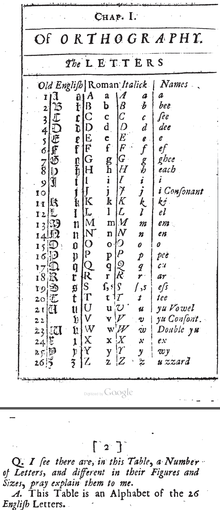English alphabet
The modern English alphabet is an alphabet used to write the English language . It conforms to the Latin alphabet and consists of 26 letters :
| Capital letter | A. | B. | C. | D. | E. | F. | G | H | I. | J | K | L. | M. | N | O | P | Q | R. | S. | T | U | V | W. | X | Y | Z |
|---|---|---|---|---|---|---|---|---|---|---|---|---|---|---|---|---|---|---|---|---|---|---|---|---|---|---|
| lowercase letters | a | b | c | d | e | f | G | H | i | j | k | l | m | n | O | p | q | r | s | t | u | v | w | x | y | z |
The capital letters are referred to in English as uppercase letters , capital letters or majuscule forms , the lower case letters as lowercase letters , small letters or minuscule forms .
history
The oldest language level of English, Old English , was originally written with runes . The Anglo-Saxons used the Anglo-Frisian Futhork, a further development of the Germanic rune series Futhark . Futhork is only preserved on coin inscriptions and on about 70 inscriptions on wood, bone and stone.

From around the 7th century AD, the runes were replaced by the Latin alphabet . Some characters have been added to the Latin alphabet to represent sounds from the English language that were not covered by the Latin alphabet, such as the letters Eth (Ð in upper case and ð in lower case) and Thorn (þ) for the sounds [ð] and [θ], Ash (Æ and æ) for [æ]. Furthermore, in Old English texts one can find <ȝ> (also called Yogh ) and <ƿ> ( Wynn ) for [w].
In the Middle English period (approx. 1100–1500) these additional letters gradually disappeared from the alphabet. Eth and Thorn have been replaced with <th>. Ash dropped out because the sound [æ] was replaced by the sound [a] in many words and was therefore no longer necessary. Wynn was replaced by the Latin letter ⟨w⟩. The letter <ȝ> can still be found in Middle English texts, it is replaced by <y> and <gh> in modern English. <ƿ> was replaced by <w> in modern English to avoid confusion with <p>. In Middle English, the letters ⟨k⟩, ⟨q⟩ and ⟨z⟩, which are not common in Old English, came into use.
English names of the letters of the Latin alphabet
The compilation is based on the Oxford English Dictionary .
| Capital letter | lowercase letters | Surname | IPA | |
|---|---|---|---|---|
| 1 | A. | a | ay
ai |
/ eɪ / |
| 2 | B. | b | bee | /bi/ |
| 3 | C. | c | cee | / siː / |
| 4th | D. | d | dee | / diː / |
| 5 | E. | e | ey | / iː / |
| 6th | F. | f | ef | / ɛf / |
| 7th | G | G | gee | / dʒiː / |
| 8th | H | H | aitch | / eɪtʃ / |
| 9 | I. | i | i | / ɑɪ / |
| 10 | J | j | jay | / dʒeɪ / |
| 11 | K | k | kay | / keɪ / |
| 12 | L. | l | el | / ɛɫ / |
| 13 | M. | m | em | / ɛm / |
| 14th | N | n | en | / ɛn / |
| 15th | O | O | O | /O/ |
| 16 | P | p | pee | /pi/ |
| 17th | Q | q | que | / qju / |
| 18th | R. | r | ar | / ɑː / |
| 19th | S. | s | it | / ɛs / |
| 20th | T | t | tea | / tiː / |
| 21st | U | u | you | / juː / |
| 22nd | V | v | vee | / viː / |
| 23 | W. | w | double-u | / dɑbəɫˈju / |
| 24 | X | x | ex | / ɛks / |
| 25th | Y | y | wy | / ʋɑɪ / |
| 26th | Z | z | zed
zee |
/ zɛt /
/ ziː / |
When spelling you use spelling boards, e.g. B. on the ICAO alphabet.
Diacritical marks
In contrast to the French alphabet , for example , the English alphabet does not contain letters with diacritical marks . Diacritical marks are not normally used to write English words; they appear almost exclusively in foreign words and non-English proper names.
Omitting the diacritical mark is often considered just as correct spelling, e.g. B. French cliché = English cliché or cliche .
See also
NATO alphabet or international letter tables
Individual evidence
- ↑ James Hoy, The Irish Spelling Book; or Instruction for the Reading of English, fitted for the Young of Ireland. Dublin 1740, p. 1/2, view in the Google book search
- ↑ Wolfgang Obst, Florian Schleburg: Textbook of Old English . Winter, Heidelberg 2004, ISBN 3-8253-1594-0 , p. 70 .
- ^ Keith Johnson: The History of Early English . Routledge, London / New York 2016, ISBN 978-1-138-79545-7 , pp. 40 .
- ↑ Simon Horobin, Jeremy Smith: An Introduction to Middle English . Edinburgh University Press, Edinburgh 2002, ISBN 978-0-7486-1481-3 , pp. 46-47 .

